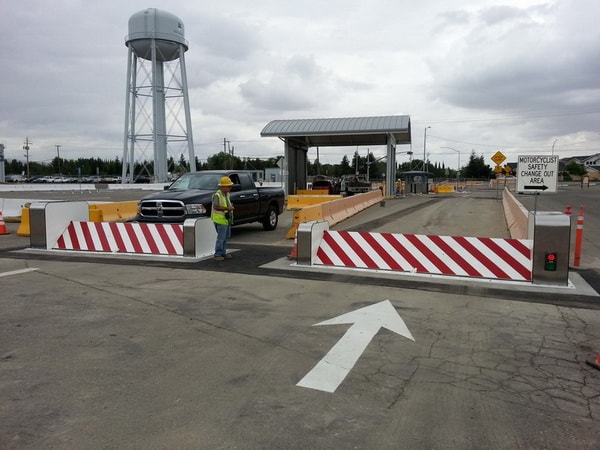Wedge Barriers Things To Know Before You Get This
Wiki Article
The 8-Minute Rule for Wedge Barriers
Table of ContentsWedge Barriers for DummiesNot known Details About Wedge Barriers

14 and the surface area 12 to which the barrier 10 is secured may be made from concrete - Wedge Barriers. 2, the barrier 10 is placed to or includes a support or subframe (e. g., anchor 30 revealed in FIG. 2 )protected underneath the surface 12. The bather 10 might be bolted to the anchor or protected to the anchor by other mechanical fasteners. In the detailed embodiment, the barrier 10 consists of a wedge plate 16, that includes a section that is substantially parallel with the surface 12 when the obstacle 10 remains in the retracted placement. In various other words, automobiles or individuals might overlook the barrier 10 when the obstacle 10 is in the retracted placement and experience mild elevation about the surface 12 while on the barrier 10. As reviewed in detail listed below, when the obstacle 10 is in the released setting, the wedge plate 16 is held and sustained in an elevated position by a training mechanism of the barrier 10. Additionally, the parts 18 may be bolted or otherwise mechanically paired to each other. In this manner, repair service or substitute of one or even more parts 18 might be streamlined and streamlined. That is, repair service or substitute of solitary parts 18 may be done faster, easily, and cost efficiently. FIG. In certain embodiments, the support 30 might be a steel structure including plates, beams(e. g., I-beams ), and/or various other structures that are secured within the structure 14, which might be concrete. At the surface 12, Full Article a top side 28 of the support 30 might be look at here at least partly revealed , thereby allowing the attachment of the obstacle 10 to the support 30. g., threaded openings)in one or even more beam of lights or plates of the anchor 30 might be subjected to the surface 12. In this way, bolts 32 or various other mechanical fasteners might be utilized to secure the barrier 10 to the anchor 30. As the obstacle 10 is placed to the surface 12 of the structure 14, collection of debris and other product under the obstacle may be lowered, and parts of the bather 10 may not be subjected to below grade environments. As shown by referral numeral 52, the training system 50 consists of elements disposed below the wedge plate 16. For example, the components 52 below the wedge plate 16 might consist of an electromechanical actuator, a cam, several webcam surface areas, etc. In addition, the training device 50 consists of a springtime setting up 54
The springtime pole 58 is paired to a web cam(e. g., web cam 80 displayed Our site in FIG. 4) of the lifting mechanism 50. The springs 60 disposed regarding the spring rod 58 are kept in compression by springtime supports 62, including a taken care of springtime assistance 64. That is, the fixed springtime support 64 is dealt with family member to the foundation 14 et cetera of the bather 10.
The 7-Minute Rule for Wedge Barriers
The continuing to be force applied to the cam to deploy release wedge plate 16 may be provided given an electromechanical actuator 84 or other actuator. The springtime setting up 54 and the actuator 84(e. Wedge Barriers. g., electromechanical actuator)may run with each other to translate the webcam and lift the wedge plate 16.
As discussed above, in the deployed position, the wedge plate 16 offers to obstruct access or traveling beyond the obstacle 10. The obstacle 10(e. g., the wedge plate 16 )may block pedestrians or automobiles from accessing a residential property or pathway. If an automobile is taking a trip towards the released wedge plate 16(e. For instance, in one condition, the safety legs 86 may be prolonged throughoutmaintenance of the barrier 10.
Report this wiki page